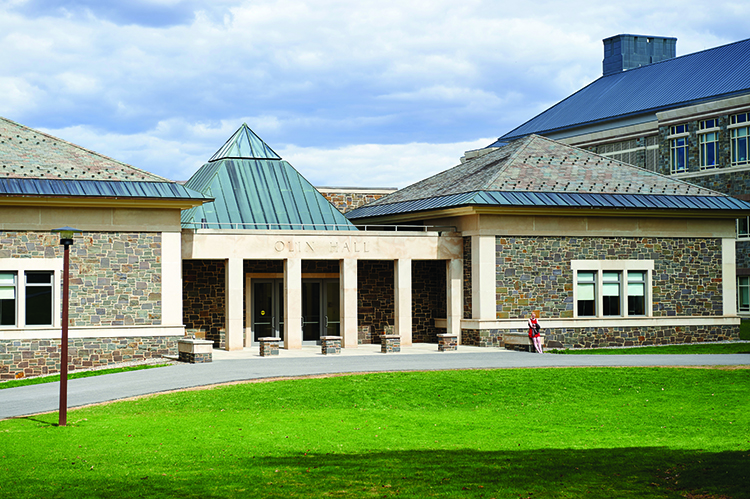A Sense of Place
This issue of Colgate Magazine presents “Places of Imagination” — the histories of those spaces on campus that are special, that live somewhere in the memory. These are the locations that resonate even after years of being away from campus. It is impossible to think about Colgate without thinking of these corners and quadrangles. In fact — far more than is the case at most campuses — Colgate has a certain powerful placeness that seems almost definitional. The combination of Taylor Lake, the long sweeping fields up to the upper campus, and the stone buildings ascending upward with their cupolas creates a distinct environment that shapes not only memory, but also experience. And the weather. Always the weather. Can you really think of your time at Colgate without thinking of the weather on this Hill and the snow piling up against stone buildings?
Campuses should be beautiful (Name an important college or university in the world that isn’t.). Beauty matters, perhaps far more than we know, or are willing to acknowledge.
Sometimes it can seem odd, or potentially frivolous, to state that a campus should be beautiful. With all that is going on in the world, or that is wrong with it, why focus on appearance? We face so many problems, both here and in the world, that any attention paid to the beauty of the campus might seem like an effort misspent.
It is not. Our built environment shapes how we move about, how we relate to one another, how we connect. And, as this edition of this magazine shows, it shapes memory. It is part of the education of every Colgate student.
In the years ahead, we will witness a significant rebuilding, refurbishing, and reimagining of this campus, and thus of Colgate itself.
With recent, extremely generous gifts from Robert H.N. Ho ’56, H’11 and Dan Benton ’80, H’10, P’10, we will see the refurbishment and expansion of Olin Hall to house the Robert Hung Ngai Ho Mind, Brain, and Behavior Initiative and the creation of the Benton Center for Technology and Innovation in what we now call the Middle Campus. These are just the first of the projects. Others will include:
- The Upper Campus. With the removal of Gate House and 113 Broad Street, we will have to construct residence halls to house a significant number of students up on the Hill, near the main academic quadrangles.
- The Middle Campus. In the area of the campus that extends from Case-Geyer to Dana (what is currently a mismatch of mid– and late–20th-century buildings), a new academic quadrangle will emerge that will house Colgate’s programs in arts, creativity, and innovation, as well as our entrepreneurship program.
- The Lower Campus. Currently, Colgate juniors and seniors live in a jumbled array of housing options, ranging from large houses on Broad Street to the apartment complexes along College Street. Can we imagine this part of Colgate appearing as an inclusive part of the campus?
- The Athletics Campus. Reid Athletic Center was built when Colgate was not coed, when we sponsored fewer than a dozen sports, and when the NCAA had yet to array itself into divisions. It is now wholly inadequate for the level of achievement we have seen — and now regularly expect — of our athletics teams. It is also profoundly unattractive. This building, which announces that one has arrived at the campus from the south, must reflect the caliber of our program.
We also must take care of the environment, minimizing our footprint on the landscape and encouraging new ways of moving toward and about
the campus.
We will make these changes as resources allow. And, importantly, we will be guided by the beauty of this campus and our obligation to honor our first two centuries, while planning this next one. One of the challenges of thinking about a campus for a new century is to think how best to honor the look and the feel of existing buildings and quadrangles, while also moving the institution forward.
We learned we could do this with Burke and Jane Pinchin halls. We will continue to seek to get this right. The places of imagination of our Colgate grandchildren and great-grandchildren will be built by us today.

